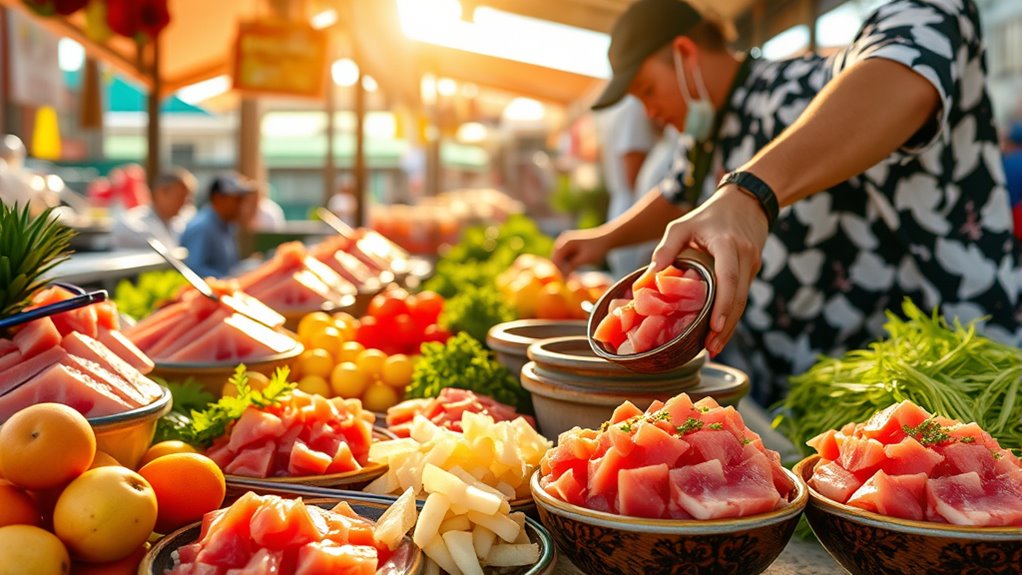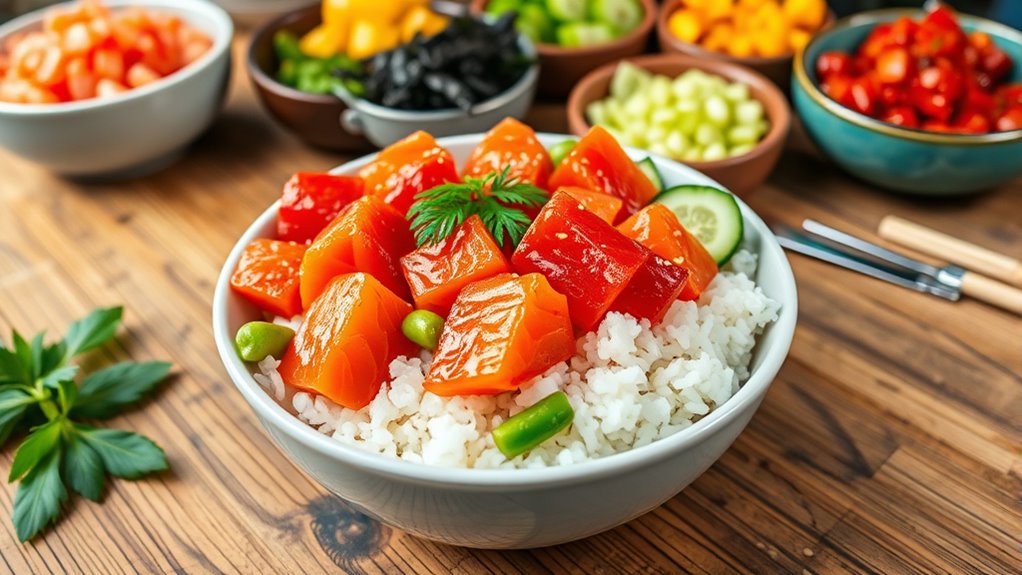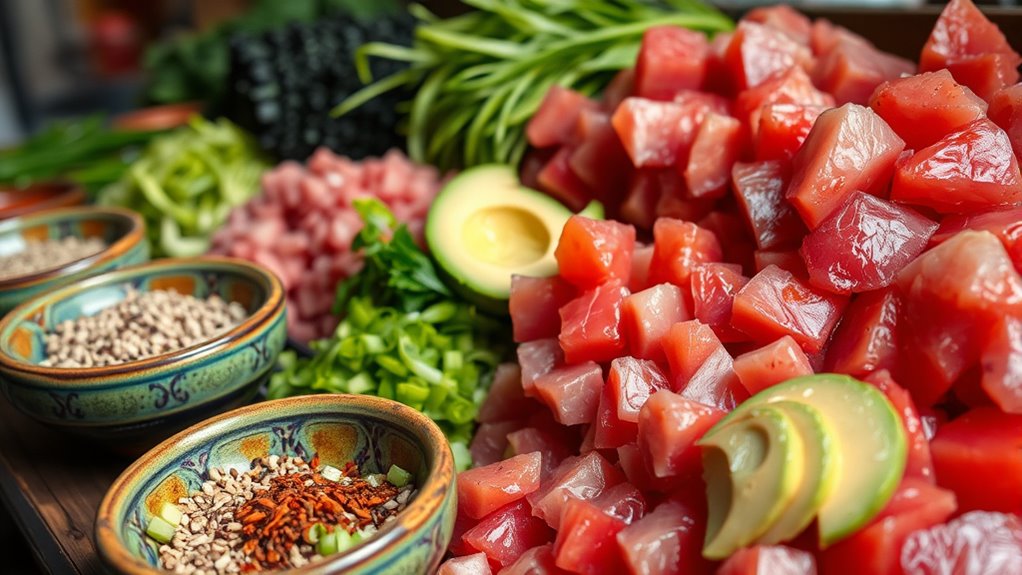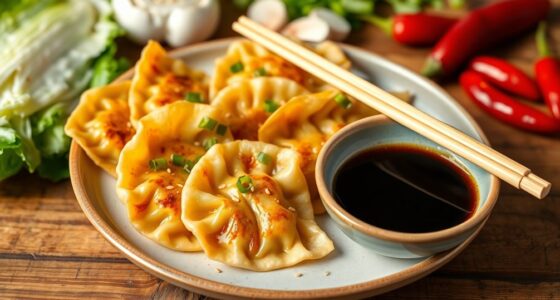Hawaiian poke starts with selecting fresh, high-quality fish like ahi or octopus, handled with care to prevent contamination. It’s traditionally seasoned with simple ingredients like sea salt, soy, and green onions, highlighting ocean flavors. Modern versions embrace creative twists, adding fruits, spicy sauces, or crunch. Proper storage, hygiene, and quick assembly guarantee safety and peak freshness. If you want to learn more about bringing authentic poke from market to bowl, keep exploring these steps.
Key Takeaways
- Fresh, high-quality ingredients are essential, from selection at markets to proper storage and handling before preparation.
- Traditional poke emphasizes minimal processing, seasoning fish with sea salt, soy, and herbs to preserve natural flavors.
- Proper hygiene, sanitation, and temperature control during handling prevent contamination and ensure food safety.
- Proper assembly and presentation highlight the dish’s freshness, maintaining ingredient integrity from market to bowl.
- Modern variations blend traditional methods with innovative toppings and global influences, reflecting evolving culinary trends.
The Origins of Poke in Hawaiian Culture

Poke has deep roots in Hawaiian culture, dating back centuries as a traditional way for fishermen to prepare and enjoy their catch. Originally, fishermen would dice their freshly caught fish, often ahi or octopus, and season it simply with sea salt, local herbs, and occasionally seaweed. This method allowed them to preserve and savor their fish quickly after returning from the ocean. Over time, poke became a communal food, shared among families and villagers, symbolizing a connection to the sea and the land. Its simplicity reflected the resourcefulness of Hawaiian life. Additionally, the practice of spiritual rituals surrounding food preparation emphasized gratitude and respect for the ocean’s bounty. Today, while modern ingredients and flavors have expanded how poke is prepared, its origins as a straightforward, fresh, and communal dish remain at its core. The use of local ingredients continues to honor traditional practices and regional flavors.
Traditional Ingredients and Preparation Methods

Traditional poke ingredients focus on fresh, minimally processed elements that highlight the natural flavors of the ocean. You typically start with high-quality raw fish like ahi or yellowtail, cutting it into bite-sized pieces. To season, you use simple ingredients such as soy sauce, sesame oil, and a touch of sea salt, allowing the fish’s freshness to shine. You might add chopped green onions, seaweed, or Hawaiian salt for extra flavor. Preparation involves marinating the fish briefly, ensuring it absorbs the seasonings without overpowering its natural taste. Often, you serve poke over rice or greens, emphasizing simplicity and freshness. The emphasis remains on preserving the integrity of the ingredients, making each bite a true reflection of traditional Hawaiian culinary principles.
The Evolution of Poke in Modern Hawaii

As Hawaii’s culinary scene evolves, so does the way people enjoy poke. Today, traditional flavors blend with global influences, creating a diverse array of options. Modern poke bowls often feature unexpected ingredients like spicy mayo, avocado, or even tropical fruits, reflecting Hawaii’s multicultural influences. Chefs experiment with different proteins such as salmon, octopus, or tofu, moving beyond classic ahi. Additionally, the rise of pinball machines and related gaming culture highlights how entertainment options continue to diversify alongside culinary trends. Convenience also plays a role; poke has become a fast-casual favorite, available in supermarkets, food trucks, and dedicated poke shops. This evolution keeps the dish fresh and relevant, attracting new generations while respecting its roots. Understanding consumer preferences helps chefs innovate while honoring traditional flavors, allowing for a vibrant, customizable experience that celebrates Hawaii’s culinary innovation. Moreover, the increasing adoption of merchant services facilitates quick and secure transactions for these numerous poke venues, supporting the industry’s growth. Additionally, the incorporation of cultural sensitivity ensures that the diverse origins of poke are respected and celebrated in modern adaptations. Recognizing cookie management practices can further enhance customer trust and transparency in the digital aspects of these eateries.
Popular Variations and Creative Twists

Many chefs and food enthusiasts are pushing the boundaries of classic poke by experimenting with bold flavors and unexpected ingredients. They’re adding spicy elements like sriracha or wasabi to create fiery versions, while others incorporate tropical fruits such as mango or pineapple for a sweet contrast. Creative twists include using different proteins like tofu, salmon, or octopus, expanding beyond traditional ahi tuna. Some add crunchy toppings like tempura flakes or crispy onions for texture. Others play with sauces—think coconut milk, ponzu, or sesame oil—to craft unique profiles. These variations keep poke exciting and versatile, appealing to a broad range of tastes. Whether you prefer spicy, fruity, or savory, exploring these creative twists allows you to personalize your poke bowl and enjoy new flavor combinations.
Poke’s Global Popularity and Influences

Poke’s popularity has surged worldwide, transforming from a local Hawaiian delicacy into a global phenomenon. This rise reflects how diverse culinary influences blend into a dish loved across continents. You’ll see three main factors driving this trend:
- Increased health consciousness fuels demand for fresh, protein-rich meals like poke.
- The rise of food social media spreads visually appealing dishes, making poke trendy everywhere.
- Global fusion cuisines adapt poke with local ingredients, creating new flavors and attracting broader audiences.
- Additionally, the alarm clock craze emphasizes quick, convenient meal options like poke bowls for busy lifestyles.
- The nutritional benefits of poke, including its high protein content and healthy fats, contribute to its widespread appeal among health-conscious consumers.
- The incorporation of Pimple Patch technology in some skincare routines underscores a growing focus on targeted, effective solutions for skin concerns.
- Advances in sound design and multimedia presentation help showcase poke recipes through engaging visuals and immersive content, further boosting its popularity.
- As the demand grows, many restaurants are experimenting with creative toppings and presentation styles to cater to diverse tastes and preferences.
As a result, poke’s influence extends beyond Hawaii, inspiring innovative variations and inspiring chefs worldwide. Its versatility and fresh appeal continue to fuel its popularity, making it a staple in restaurants and bowls around the globe.
Tips for Making Authentic Poke at Home

To make authentic poke at home, start with high-quality, fresh seafood like sushi-grade tuna or salmon, as this forms the dish’s core flavor and texture. Use a sharp knife to dice the fish into bite-sized cubes, ensuring clean cuts. Marinate with traditional ingredients such as soy sauce, sesame oil, and a touch of Hawaiian sea salt, then gently toss to coat evenly. Keep your poke chilled until serving to preserve freshness. Remember, the key to authentic taste is simplicity—avoid overpowering flavors. Incorporating temperature control techniques can help maintain the quality of your seafood. Additionally, being aware of local spearfishing regulations can ensure you source your seafood responsibly. Practicing mindful food sourcing supports sustainability and ensures the best quality for your poke. Regularly monitoring food safety guidelines can also prevent contamination and spoilage.
Frequently Asked Questions
How Has the Sustainability Movement Impacted Poke Ingredient Sourcing?
The sustainability movement has considerably influenced how you source poke ingredients. You now prioritize eco-friendly practices, like selecting sustainably caught fish and organic vegetables. You seek vendors who use responsible fishing methods and reduce waste. This shift encourages better environmental stewardship and ensures the ingredients remain available for future generations. By making mindful choices, you contribute to a healthier planet while enjoying authentic, responsibly sourced poke bowls.
What Are the Health Benefits Associated With Traditional Poke?
You might think traditional poke is just a tasty dish, but it actually offers health benefits too. It’s packed with high-quality protein from fresh fish, which helps build muscle and keeps you full longer. Plus, the fish provides omega-3 fatty acids, supporting heart and brain health. The fresh vegetables add vitamins and fiber, aiding digestion. So, enjoying traditional poke isn’t just delicious—it’s a smart choice for your well-being.
Are There Regional Differences in Poke Preparation Across Hawaiian Islands?
You’ll notice regional differences in poke preparation across the Hawaiian islands. In Oahu, you might find more variety with added ingredients like seaweed and spicy sauces, while on the Big Island, traditional styles focus on fresh fish and simple seasonings. Maui often features local influences, blending flavors unique to that area. These variations reflect local tastes, available ingredients, and cultural influences, making each island’s poke a distinct culinary experience.
How Do Modern Dietary Trends Influence Poke Recipes?
Imagine your plate as a blank canvas, waiting for bold, fresh strokes. Modern dietary trends shape your poke recipes by encouraging lighter, healthier choices, like swapping traditional mayo for avocado or using low-sodium soy sauce. You’re the artist, blending vibrant ingredients that satisfy your taste buds and nourish your body. These trends inspire you to explore new flavors, turning your poke bowl into a delicious reflection of your health-conscious lifestyle.
What Are the Best Seasonal Ingredients for Making Poke?
When choosing seasonal ingredients for poke, you should focus on fresh, ripe produce that enhances flavor and texture. Opt for in-season fruits like mango or pineapple, and vegetables such as cucumbers or radishes. Fresh herbs like cilantro or green onions add brightness. Using seasonal ingredients guarantees your poke is vibrant, flavorful, and reflects the best produce available, making each bite more enjoyable and aligned with seasonal freshness.
Conclusion
Now that you know the rich history and fresh flavors of Hawaiian poke, you’re ready to jump in and create your own bowl. Remember, the best poke is all about fresh ingredients and a little creativity. Don’t be afraid to put your spin on it—after all, variety is the spice of life. So, go ahead and give it a shot; you’ll be hooked in no time, and it’s sure to be a hit at any table.









